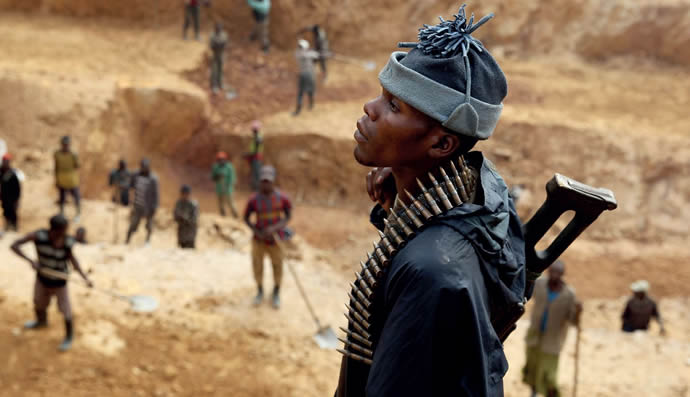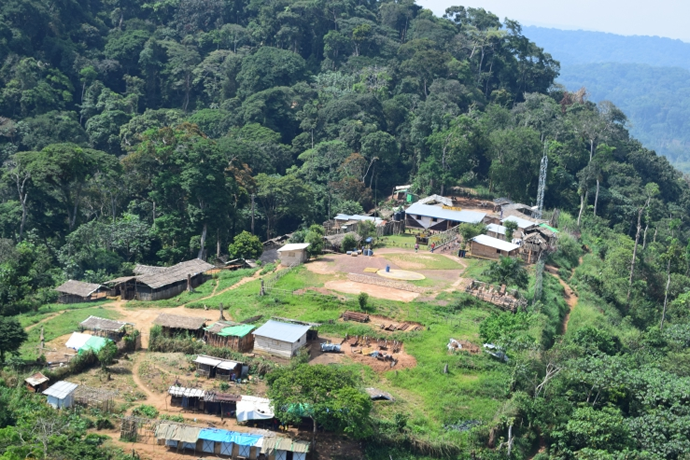Is progress being made to eradicate conflict minerals?
Electronic Specifier Editor Joe Bush talks to Constantin Bloome, Professor of Operations Management at the University of Sussex, about how best to stop the trade in conflict minerals.
The extraction and sale of conflict diamonds (or ‘blood diamonds’), was brought to the attention of the world in 2006, with the release of the eponymous film starring Leonardo DiCaprio and Djimon Hounsou. However, a phenomenon which is less well known within the public psyche, but one which takes place under almost identical circumstances, is the proliferation of conflict minerals, which has long been a concern within the electronics industry.
Conflict minerals are essentially natural resources that are mined in war zones around the world - such as the Kivu region of the Democratic Republic of Congo (DRC), and as such, have helped fund terrorist and rebel groups, prolong conflicts, contribute to economic and political instability and exacerbate human rights abuses.
Primary examples of conflict minerals include tin, tungsten, tantalum and gold (more commonly referred to as 3TG). They are by no means the only source of income to armed groups, but are by far the most lucrative. These minerals are utilised by multi-national electronics companies and are essential for the manufacture of a variety of consumer devices such as mobile phones and laptops. A smartphone for example, contains around 40 different minerals, each performing a role that is essential to the device’s functionality. As a consequence there has been a concerted international effort over the last few years to reduce the trade in conflict minerals. 2010 saw the introduction of the Dodd-Frank Wall Street Reform and Consumer Protection Act (US), while in Europe there is the OECD Due Diligence Guidance for Responsible Supply Chains of Minerals from Conflict-Affected and High-Risk Areas. Bloome commented: “The last five years has seen a marked change in the attitude towards conflict minerals – they’ve existed for years but the western world hasn’t always paid much attention to them. The Dodd-Frank legislation in the US, which was pushed through in 2010, is a very drastic way of changing auditing practices, and requires firms to audit the full supply chain and monitor it up to the source.
“In Europe it’s quite different - we still don’t have any legislation. We have the OECD guidance which has been around for a few years and has brought the issue of conflict minerals into the public eye. Companies are now pretty concerned about it, to the point where practices are actually changing. We still don’t know for sure where it’s heading, but I would think that European legislation will follow in time, although it probably won’t be as strict or as drastic as the legislation in the US. It should be noted that Dodd-Frank only focuses on DRC and surrounding regions. However, people are still dying in the mines of Colombia for example. So Dodd-Frank is a little bizarre in that regard as it’s only focusing on one area, so in some instances it’s easier for companies to just source their minerals elsewhere - drying up the market in the DRC to a certain extent. OECD however, talks about conflict areas in general rather than just the DRC, so it is much fairer.”

Above: conflict minerals have helped fund terrorist and rebel groups, prolong conflicts, contribute to economic and political instability and exacerbate human rights abuses
Five years on from the Dodd-Frank Act, progress has undoubtedly been made with regards to reducing the number of conflict mines in the DRC. However, it is estimated that there is still a lack of reliable data, an absence of standard certification schemes, a lack of supply chain coordination and clarity of responsibility (leading to problematic auditing processes), unclear terminology and accountability loopholes. Bloome continued: “Overall I would say Dodd-Frank has been a success however, studies have shown that the sustainability levels in the DRC itself haven’t increased a great deal as companies tend to circumvent sourcing from that country, ultimately resulting in worse working conditions for the miners. This is obviously an issue as most companies wouldn’t admit that they’d rather source from elsewhere, but it happens and it’s understandable if you make things more complicated for firms and there’s another easier and cheaper method available. So there are negative impacts and it’s certainly unfair to discriminate against only one region, but overall the law has been a positive and without it we simply wouldn’t be talking about the problem.”
Conflict minerals in numbers
At present revenue generated via mines in the DRC accounts for around 75% of the revenue generated by the various armed groups in the country, such as the Democratic Forces for the Liberation of Rwanda (FDLR), but also rogue brigades within the armed forces of the Democratic Republic of Congo (FARDC) - the Congolese national army. In addition, around 35% of the DRC’s mineral profits end up in the pockets of such groups.
A study between 1998 and 2007 revealed that there has been approximately 5.4 million deaths in the DRC as a result of civil conflict – which is around the same number as the Vietnam War, Korean War and US Civil War combined (there has been no follow-up study conducted since then on the mortality toll). The Dodd-Frank Act has been successful in reducing mineral revenue to militias, however, smuggling still represents a major issue, having an involvement in around 65% of current mineral trade.
Latest prevention news
Speaking on the impact of guidance and legislation, Bloome added: “OECD is a suggestion and a recommendation on how to avoid the problem of conflict minerals. It’s not mandatory so the organisations that are active and using it are doing so because they want to and have a desire to enact change. With laws like Dodd-Frank you have to ask, are firms really interested? Perhaps. Some of the bigger players have made a concerted effort and I commend them for that and they’ve helped alter the industry, but there’s also an argument to say that often it’s a greenwashing, box ticking exercise.
“Most of the firms following OECD are not implementing it fully, but they are guiding the practices of the firms involved – which is a check-up framework that actually helps to lower the risk of conflict minerals. What I would say is that the Dodd-Frank Act has changed the practice of a lot of firms and has definitely raised awareness. OECD has been taken up by less firms to a certain extent, as it’s not mandatory, but you’ll probably find more convincing implementations as firms are involved because they want to be rather than because they have to.” It should also be noted that cost, the prohibitive factor commonly cited by companies as a barrier to the implementation of optional due diligence, are relatively small for most organisations and can be as little as 0.01% of overall sales. And this can be more than offset in savings as a result of industry collaboration initiatives and reliable upstream due diligence.
A new report from the University of Sussex, authored by Bloome, has stated that two major weapons in the battle against conflict minerals are collaboration between companies and greater pressure from consumers.

Relatively simple and cost effective collaboration measures have been suggested such as the sharing of lists of certified smelters and refineries. It is thought that this collaboration would also facilitate audits through the sharing of information, standardising certification schemes and enabling and enhancing traceability. Responsibly sourced minerals will also enhance a firm’s reputation, improving investor relationships and risk management.
The report has also urged consumers to play their part by applying pressure on companies to source responsibly via campaigns and purchase choices, which will result in increased transparency and compliance. This is something that has already had an impact on the distribution of conflict diamonds within the jewellery industry. Although the supply chain here is less complex, there is a greater awareness of the ‘blood diamonds’ issue, and as a result, customers have placed greater pressure on the industry to source more responsibly.
The future
“One organisation alone cannot tackle conflict minerals,” added Bloome. “I think the electronics industry has made good ground here as they have been collaborating with organisations like the Electronic Industry Citizenship Coalition (EICC) - working together on the problem, and that’s definitely the way to go. They have been exchanging information and been doing joint work on the ground in the countries themselves, which helps to share costs and enables access to a greater level of expertise. The industry could do even more but of course it’s a huge market, some efforts are still isolated and there are missed opportunities, so there needs to be even more collaboration on transparency of data, but also to change behaviour on the ground and to educate suppliers.
“Any awareness around issues such as conflict minerals is ultimately beneficial as that’s the first step towards change - so from a consumer point of view, the more pressure they put on the market the more will happen. I see a big change happening here. We are in an era where consumers are requesting more transparency in supply chains in general - whether it be food, apparel or conflict minerals, and I think there will be increased legislation across all supply chains. Is there enough awareness around the topic - maybe not. People ultimately care about this issue but it’s certainly questionable whether there is enough concern to change behaviour. For example, when there’s been issues surrounding child labour in the past within certain industries, has it really altered the majority of peoples’ buying habits?
“The conflict minerals problem was probably at its worst during the unrest in Rwanda in the 1990s when military groups went into the DRC. Now awareness has increased to a point where it’s not getting worse. It’s a problem that we can stop - it’s not impossible. I’m relatively positive because it’s not a problem like child labour - a global problem on a huge scale that’s widespread and entrenched culturally in some parts of the world. Conflict minerals on the other hand are bound to the mines so you can actually tackle the problem far more easily. With concerted efforts, more transparency in the supply chain and an actual willingness to change behaviours, it’s doable and it’s time to fight back.”


